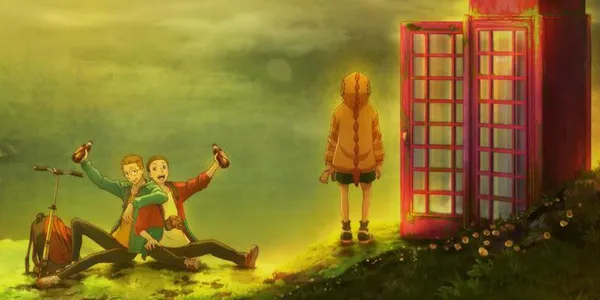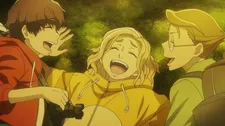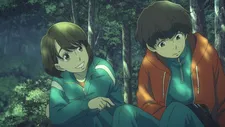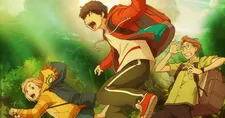 |
| Goodbye Donglees! |
A hit with festival audiences at Fantasia and now in Edinburgh, adapted into a manga series in its native Japan and looking forward to a UK release, Goodbye Don Glees! is the latest offering from Madhouse Studios’ Ishizuka Atsuko, one of the leading lights of Japanese animation. It follows lifelong best friends Roma and Toto, together with their new friend Drop, as they travel through the forest beside their hometown in search of a lost drone. Facing separations both known and unknown, they talk about small things whilst hiding from the big ones, but friendship which may no longer work the way it did still has the potential to take new forms and transport them to new and unexpected places.
“I wanted to write a drama story about changes in life, how people change and how people feel things differently, how they think and how they evolve as a person, through dialogues and changing characters and also the discoveries you make as you go on in life, and that's how this started,” Atsuko tells me when we meet.
 |
| Goodbye Don Glees! Photo: Courtesy of Fantasia International Film Festival |
She’s an unusually composed, quiet person whose sharp eyes reveal that she’s taking in everything around her, picking up on parts of what I’m saying even though we’re using a translator. She speaks with no hesitation and it’s not hard to see how she has managed to climb so high in a career which, until recently, was difficult for women to get a start in.
“During the pandemic, people have been going on the internet a lot, and we think we understand the world but are we only looking at it on our devices,” she says. ”We think this gives us access the world but in fact maybe our viewpoint is smaller because everything is here. Somehow physicality and actual experience really, really change your viewpoint. And also in the movie one of the boys says ‘Oh, there is no bear in these mountains!’, but obviously that’s information that he’s found on the internet. In fact there are bears in the mountains.”
The encounter with a bear is what sends the boys fleeing in panic, precipitating the rest of their adventure when they find themselves lost. The drone itself, and the filming which the boys do, is not all that important, she says, and it isn’t related to her own experience of starting out as a filmmaker, when she was always more interested in capturing emotions and showing people fun things than in recording events.
That's interesting, I say, because a lot of what happens in the film is about emotion and about things which are not addressed directly in words.
“I do think a lot about non-language expressions,” she says “Words people tend to take literally, but human emotions are much more complicated, so having beautiful words was compelling but because it's a movie it’s about visuals, so I focused most of my attention on the visual side of it.”
I’ve heard that an English version of the film has just been released, and I ask her if she worked with that voice cast, but she says, laughing, that she hasn’t even seen it yet. She’s full of praise for the Japanese cast. “They are the top three voice actors that you can find. I had a shortlist and I really wanted to get the right actors for these three characters because they are there from beginning to end. I needed actors who could express these emotions.”
 |
| Goodbye Donglees! |
I ask her about the settings in the film, noting that the narrow roads in the village and then the trees around the characters mean they're always in small spaces and they can't see very far. Was that an intentional metaphor for the limited social horizons of the characters, or at least of central character Roma?
“It is actually exactly that,” she says. “In Japan, in the mountains. It's really dense and dark because there are so many tall trees around, so once you're in the mountains you can’t really see anything, and you definitely can’t see distance. But on the other hand, in Iceland there are no tall tree. It’s a vast, empty land, so what I remember is somebody said if you get lost in Iceland, get up, stand up tall, but in Japan, in the mountains, keep moving, try to find an open space. So it's just a polar opposite and I wanted to have that aspect in my film as well.”
The sky seems to offer a different point of focus, a reminder that the universe is bigger than that, I suggest. Weather also has a lot of presence in the film.
“Whatever the characters were feeling, I thought about it and then I came up with the weather or the sky,” she explains. She felt that the sheer number of trees we see in the film gets boring, “but the point is, to the boys, that's their world. Their world is small so they really can't see beyond that. But they look at the sky and it’s a different, wide world, so there's an unknown world that they're aware of that and their world is getting bigger. So it’s a depiction of growing up and also about their emotions.
“The storm is a depiction of how Drop is feeling, because for him, the storm is like the end of the world. Because he grew up in Iceland, so he knows that nature isn't about looking beautiful, and it could be a huge threat.”
Thinking about threat from there are some great action scenes in the film. Was it important to show that the young people could actually be in danger as part of the process of learning and growing up?
 |
| Goodbye Donglees! |
“Yes, definitely. And also, as a child you want to do the adventure but you are not able to, and as a grown up you think, ‘I would have wanted to do this.’ And also I wanted to have that kind of life-changing chance meeting between friends.”
Although the film was animated, it was still affected by the Covid-19 pandemic, which limited her ability to go on research trips, she explains. “I had to do the work from my own imagination. So there’s some fiction. I had to create a beautiful landscape for these boys, I had to think about how I could make it pretty visually and also create the right atmosphere. For example, for the waterfall scene towards the end there's photographs that I used for my research, but actually the waterfall in the film is much bigger than the real one. So this is my imagination and I think that worked out really well as a result.”
There’s also a red telephone box near that waterfall...
“I really, really wanted to go to Iceland and I hated it because I couldn't go, so I went around Iceland so many times online, and then I just found this image of this red phone box in the middle of nowhere and I just fell in love with it so I really wanted to use that in the film.”
She was worried that the film might not work for audiences outside Japan. “For example, we talked about Iceland as the edge of the world. But for you, Iceland isn't as far is it for us. But if you go and buy a world map in Japan, Iceland's actually the far corner on the left side of the map. So people might get a bit weird or not actually get that concept of these boys going to the end of the world. But I was in Edinburgh and after the screening I stayed for the feedback, and I spotted a few people crying. I was moved by that. It's a really small story of these teenage boys in Japan, and that people appreciate that globally, that they connect with the story of this human drama...” She loses her cool momentarily and smiles like a child who has been given an ice cream. “I feel like I'm a little bit more confident.”
She has a few more projects which she’s working on at present, she says, and she hopes that before too long she will return to Edinburgh and to festivals around the world.





















